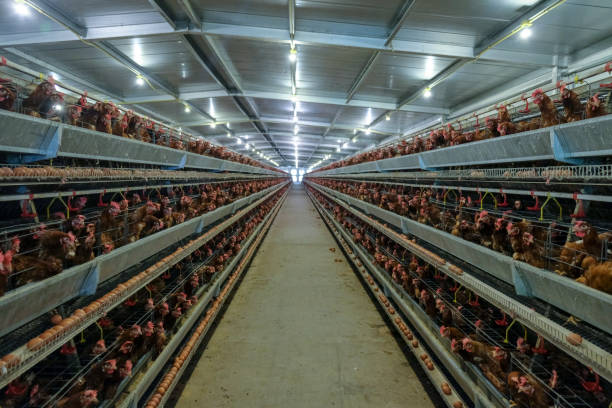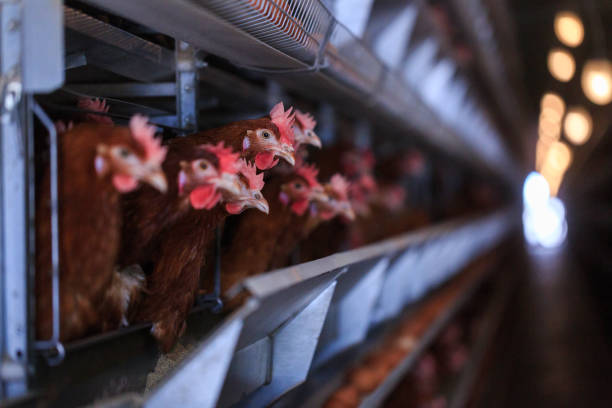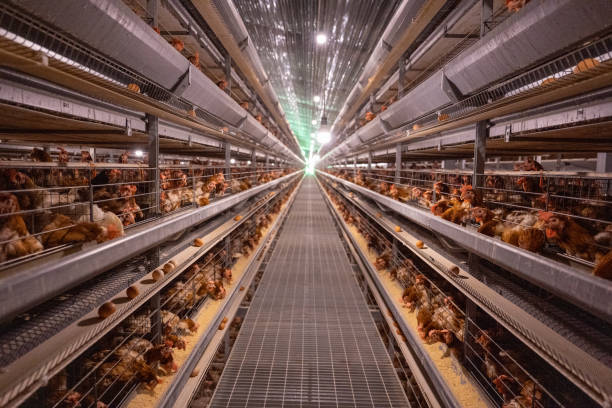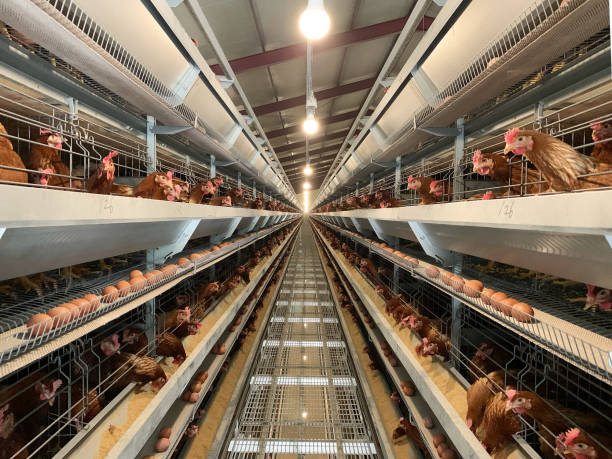
Maximize Your Poultry Farm Profits with Cage Systems in Cameroon
Maximize Your Poultry Farm Profits with Cage Systems in Cameroon
Poultry farming in Cameroon is on the rise, and if you’re looking to get in on the action or boost your existing operation, you’re likely exploring every avenue to maximize your profits. One of the most impactful decisions you can make is choosing the right housing system. While traditional free-range and deep litter systems have their place, cage systems are increasingly becoming the preferred choice for many poultry farmers in Cameroon due to their efficiency, biosecurity benefits, and ultimately, their potential to enhance profitability. Let’s dive into how cage systems can help you achieve poultry farming success in Cameroon.
What are Cage Systems and Why are They Gaining Popularity in Cameroon?
Cage systems, as the name suggests, involve housing chickens in individual or small group cages. These cages are typically arranged in rows and tiers within a poultry house. They come in various designs, but the most common types in Cameroon include:
Layer Cages: Designed specifically for egg-laying hens, these cages usually house several birds per cage and incorporate features like sloped floors for easy egg collection and feed and water troughs.
Broiler Cages: Used for raising meat chickens (broilers), these cages are designed for rapid growth and efficient feeding. They often have more floor space per bird than layer cages to accommodate their larger size.
The rising popularity of cage systems in Cameroon is driven by several key factors:
Increased Biosecurity: Cage systems make it easier to isolate and manage flocks, reducing the risk of disease outbreaks – a major concern for poultry farmers.
Higher Stocking Density: Cage systems allow you to house more birds in a given area compared to free-range or deep litter systems, leading to greater production output.
Improved Feed Conversion Ratio: With less bird movement and reduced competition for feed, chickens in cages tend to convert feed into eggs or meat more efficiently.
Easier Management: Cage systems simplify tasks like feeding, watering, egg collection, and waste removal, reducing labor costs.
Better Egg Quality: Eggs laid in cages are generally cleaner and have a lower risk of contamination compared to eggs laid on the floor.
Benefits of Using Cage Systems in Your Poultry Farm in Cameroon
Here’s a more detailed look at the specific advantages you can expect when you adopt cage systems in your poultry farm in Cameroon:
Enhanced Biosecurity and Disease Control: One of the biggest challenges facing poultry farmers in Cameroon is disease outbreaks, which can wipe out entire flocks and devastate profits. Cage systems significantly reduce this risk by limiting bird-to-bird contact and preventing chickens from coming into contact with contaminated litter or soil. This makes it easier to monitor the health of your birds and implement targeted treatments when necessary.
Optimized Space Utilization and Increased Stocking Density: Land can be a precious resource, and cage systems help you make the most of it. By housing birds in multiple tiers, you can significantly increase the number of chickens you can raise in a given area. This leads to higher overall production and greater profitability. For example, a poultry farmer using a deep litter system might be able to house 5-7 birds per square meter, while a cage system could allow for 15-20 birds per square meter.
Superior Feed Conversion Ratio and Reduced Feed Wastage: Feed is a major expense in poultry farming, often accounting for 60-70% of total production costs. Cage systems help you minimize feed wastage and improve feed conversion efficiency. Since birds in cages have less opportunity to roam and expend energy unnecessarily, they require less feed to produce the same amount of eggs or meat. Also, cage designs often incorporate features that prevent feed spillage.
Simplified Management and Reduced Labor Costs: Cage systems make farm management much easier and more efficient. Feeding, watering, and egg collection can be automated, reducing the need for manual labor. Waste removal is also simplified, as droppings fall directly beneath the cages and can be collected at regular intervals. This can significantly lower your labor costs and free up your time to focus on other important aspects of your business.
Improved Egg Quality and Reduced Egg Breakage: Eggs laid in cages are generally cleaner and less likely to be contaminated with bacteria or dirt. The sloped floors in layer cages allow eggs to roll gently into collection trays, reducing the risk of breakage and ensuring a higher percentage of marketable eggs.
Controlled Environment and Reduced Stress: Modern cage systems can be integrated with environmental control systems, such as ventilation and temperature control, to create a more comfortable and stress-free environment for your chickens. This can lead to improved bird health, better production performance, and reduced mortality rates.
Choosing the Right Cage System for Your Farm in Cameroon
Selecting the appropriate cage system is crucial for maximizing its benefits. Here are some factors to consider:
Type of Poultry: Are you raising layers for egg production or broilers for meat? The type of cage system you need will depend on the specific requirements of your birds.
Size of Your Operation: Consider the scale of your farm and your future expansion plans. Choose a cage system that can accommodate your current needs and can be easily expanded as your business grows.
Climate Considerations: Cameroon has a diverse climate, with varying levels of temperature and humidity. Choose a cage system that is well-ventilated and can be adapted to suit local conditions. Consider features like adjustable curtains or fans to regulate temperature and airflow.
Material Quality and Durability: Opt for cage systems made from high-quality, corrosion-resistant materials that can withstand the rigors of daily use and the humid climate in many parts of Cameroon. Galvanized steel is a popular choice due to its durability and resistance to rust.
Ease of Installation and Maintenance: Choose a cage system that is easy to install and maintain. Look for features like modular designs and readily available spare parts.
Cost: Consider your budget and compare the costs of different cage systems. However, don’t focus solely on the initial purchase price. Factor in the long-term benefits, such as improved feed conversion, reduced labor costs, and increased production, to determine the true value of the investment.
Essential Features to Look for in a Quality Cage System

When evaluating different cage system options, pay close attention to these essential features:
Durable Construction: The cage should be made from sturdy materials that can withstand the weight of the birds and resist corrosion.
Proper Ventilation: Adequate ventilation is crucial for maintaining air quality and preventing the buildup of harmful gases like ammonia.
Easy Access to Feed and Water: Birds should have easy and consistent access to feed and water at all times.
Comfortable Flooring: The cage floor should be designed to prevent injuries and provide a comfortable surface for the birds to stand on.
Efficient Waste Removal: The cage should facilitate efficient waste removal to maintain hygiene and reduce the risk of disease.
Egg Collection Mechanism (for Layer Cages): Layer cages should have a reliable egg collection mechanism that minimizes egg breakage and ensures clean eggs.
Adjustability: Choose a cage system that can be adjusted to accommodate the changing needs of your birds as they grow.
Integrating Cage Systems with Other Farm Management Practices
To fully realize the benefits of cage systems, it’s essential to integrate them with other sound farm management practices:
Proper Ventilation: Ensure your poultry house has adequate ventilation to maintain air quality and prevent the buildup of harmful gases. This is particularly important in cage systems where birds are housed in close proximity.
Effective Sanitation: Implement a strict sanitation program to minimize the risk of disease. Regularly clean and disinfect cages, feeding and watering equipment, and the surrounding area.
Balanced Nutrition: Provide your birds with a balanced diet that meets their specific nutritional needs. Consult with a poultry nutritionist to develop an appropriate feeding program.
Regular Health Monitoring: Monitor the health of your birds closely and take prompt action if you notice any signs of illness. Implement a preventative health program, including vaccinations and deworming, to protect your flock from common diseases.
Waste Management: Develop a responsible waste management plan to dispose of poultry manure safely and sustainably. Manure can be used as fertilizer for crops, but it must be properly treated to prevent environmental contamination.
Overcoming Challenges and Maximizing Success with Cage Systems in Cameroon
While cage systems offer numerous benefits, it’s important to be aware of potential challenges and take steps to mitigate them:
Initial Investment Costs: Cage systems can require a significant initial investment. However, consider the long-term benefits and potential return on investment when making your decision. Also, explore financing options and government subsidies to help reduce the upfront costs.
Public Perception: In some regions, there may be concerns about the welfare of chickens raised in cages. Educate consumers about the benefits of cage systems, such as improved biosecurity and egg quality. Emphasize that properly managed cage systems can provide a comfortable and healthy environment for chickens.
Power Outages: Frequent power outages can disrupt ventilation and other essential systems in your poultry house. Invest in a backup generator to ensure a continuous power supply.

Maintaining Hygiene: While cage systems simplify waste management, it’s still important to maintain a high level of hygiene to prevent disease. Regularly clean and disinfect cages and the surrounding area.
Proper Training: Ensure that your farm staff is properly trained in the management of cage systems. This includes feeding, watering, egg collection, waste removal, and disease prevention.
Conclusion: Cage Systems as a Catalyst for Poultry Farming Growth in Cameroon

Cage systems represent a significant opportunity for poultry farmers in Cameroon to enhance their profitability and contribute to the growth of the poultry industry. By improving biosecurity, optimizing space utilization, enhancing feed conversion efficiency, and simplifying management, cage systems can help you produce more eggs or meat with less resources.
While there are challenges to consider, the benefits of cage systems far outweigh the drawbacks when implemented correctly and integrated with sound farm management practices. By carefully selecting the right cage system for your needs, providing proper care and attention to your birds, and staying informed about the latest industry best practices, you can unlock the full potential of cage systems and achieve poultry farming success in Cameroon. So, take the leap and invest in a cage system – it could be the key to unlocking the next level of profitability for your poultry farm!
